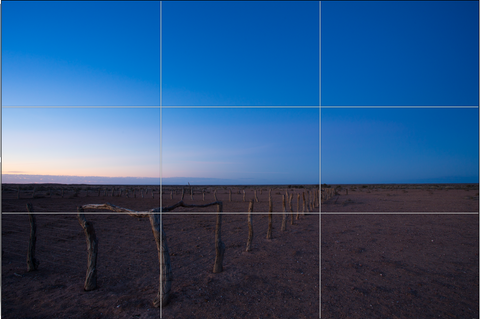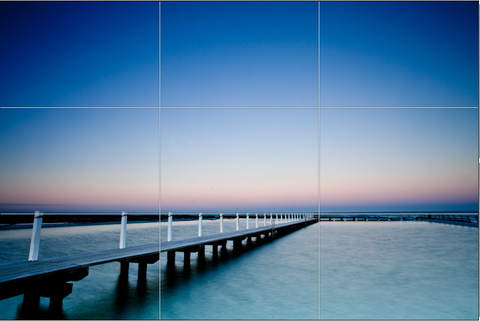Using the Rule of Thirds in Landscape Photography
Landscape photography is one of the most popular forms of photography and a great way to capture the beauty of nature. One of the most fundamental principles of photography is the rule of thirds, which can be used to create dynamic and visually appealing photos. In this blog post, we will discuss the basics of the rule of thirds and how you can use it to take stunning landscape photos.
The rule of thirds is based on the idea that our eyes are naturally drawn to certain points in an image. By dividing an image into thirds both horizontally and vertically, a photographer can create an image that is balanced and pleasing to the eye. The four points at which these lines intersect are known as power points and are the main focal points of the image. See the 4 blue dots in the image below, they are the power points and if used correctly you can compose a stunning landscape photo.

When taking a landscape photo, it's important to consider how the rule of thirds can be used to create an interesting composition. For example, you may want to place a mountain, lake, or other natural feature at one of the power points to draw the viewer's eye to the main subject of the photo. One example of this can be seen in the the peak of the mountain in The Pinnacle Landscape Photograph below. The mountain peak is right on the top left power point drawing your eye in.

In addition to the rule of thirds, there are other tips and tricks you can use to take stunning landscape photos. Paying attention to the lighting of the scene, finding an interesting angle, and including an element of surprise can all help to make your photos stand out. In the Landscape Photograph below, titled, "Radiant Glow", you can see the closest part of the rural fence has been placed on the bottom left power point and the angle of the fence is interesting and draws the viewers eye from the lower left power point to the lower right power point. The Sun light on the left of the image also assists in drawing the viewer to the left of the image before scanning to the right of the image.

You can also use the rule of thirds when taking photos of the horizon. Placing the horizon along one of the horizontal thirds of the frame can create a sense of balance and can help to emphasize the size and scale of the landscape. This technique is easy to see in the landscape image below, Narrabeen Sunset. The horizon sits on the lower third of the image. Katie has used the bottom right power point to position the corner of the ocean pool where the jetty/walkway ends. When you set up your camera to take a landscape photo, you can turn on the grid feature to see the rule of thirds on the back of your camera whilst you are shooting your landscape photograph.

The image below shows the horizon has this time been placed onto the top third of the image. With the ocean taking up the centre third and the sand taking up the lower third of the image. This is a well balanced landscape photograph following the rule of thirds.

By following the rule of thirds and experimenting with different techniques, you can create beautiful and captivating landscape photos. With a little practice and some creative thinking, you can capture the beauty of the world around you and create memories that will last a lifetime. I always encourage experimenting with any of these rules. Some rules are made to be followed and some to be broken. Don't be afraid to experiment and see what works. Don't get boxed in by the rules but also have a respect and level of appreciation for them as they can produce epic landscape photographs that will last the test of time.

